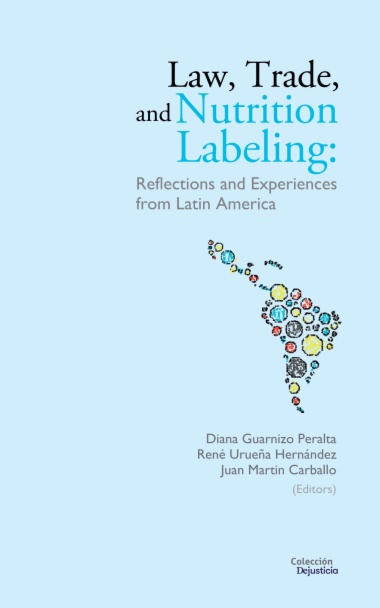The global burden of overweight and obesity is a pressing public health concern. Latin America, in particular, has high rates of consumption of sugary drinks and ultra-processed foods, making its population particularly vulnerable to non-communicable diseases (NCDs). To promote healthier eating environments and habits, the World Health Organization (WHO) and the Pan American Health Organization (PAHO) have recommended that countries adopt a set of measures, including front-of-package warning labels based on the best available scientific evidence.
Several countries in the region, such as Chile, Mexico, and Peru, have adopted the octagonal warning label model, which has demonstrated its effectiveness. However, the adoption of these and other similar policies has faced significant challenges. The ultra-processed food industry has opposed these measures, citing economic, political, and legal concerns. In particular, they have frequently argued that such policies violate international trade agreements, despite the fact that international law allows for legitimate exceptions in favor of public health.
This publication contributes to the debate on the adoption of front-of-package nutrition labeling from two perspectives. First, from a legal standpoint, the authors examine the main arguments against this public health measure and provide counterarguments based on international law. Second, from a lived experience perspective, the authors recount how they successfully advocated for this public health policy in their respective countries and overcame opposition.
The book offers a perspective from the Global South on front-of-package warning labels, one of the most important obesity prevention policies in recent years. It is aimed at academics, activists, and scholars interested in the intersections of public health, law, and international trade.
- Cover
- Title page
- Copyright page
- Content
- Acknowledgments
- Introduction: Law, Health, and the Debate on Food Labeling in Latin America
- Diana Guarnizo Peralta
- The Problem of Overweight and Obesity and the Importance of Labeling
- Law and Health: The Role of Law in the Debate on Policies for NCD Prevention
- This Book’s Role in the Debate
- References
- Part OneNutrition Labeling and International Economic Law
- Building Regulatory Sovereignty: Nutrition Labeling, Technical Barriers to Trade, and Communities of Practice
- René Urueña Hernández
- Rafael Tamayo-Álvarez
- Introduction
- Communities of Practice
- Building Regulatory Sovereignty
- Technical RegulationsTechnical Regulations
- HarmonizationHarmonization
- TransparencyTransparency
- Implications and Distributive Effects
- Conclusion
- References
- Front-of-Package Food Labeling and the Committee on Technical Barriers to Trade: A Legal Perspective on Front Labeling and International Trade
- Gianella Severini
- Juan Martín Carballo
- María Luján Abramo
- Introduction: International Trade and Diet-Related Diseases
- Food Labeling as Addressed by the Committee on Technical Barriers to Trade
- Requirements of the TBT Agreement Relevant to Front-of-Package Food Labeling
- Technical Regulations Must Technical Regulations Must Be NondiscriminatoryBe Nondiscriminatory
- Technical Regulations Must Have Technical Regulations Must Have a Legitimate Objectivea Legitimate Objective
- Technical Regulations Must Be JustifiedTechnical Regulations Must Be Justified
- Trade Concerns Raised over Front-of-Package Labeling
- “Front-of-Package Labeling Measures Are “Front-of-Package Labeling Measures Are More Trade Restrictive Than Necessary”More Trade Restrictive Than Necessary”
- “Front-of-Package Labeling Measures Lack “Front-of-Package Labeling Measures Lack Sufficient Evidence to Show That They Sufficient Evidence to Show That They Are Necessary or Strike a Proportional Are Necessary or Strike a Proportional Balance between the Trade Restriction Balance between the Trade Restriction and the Intended Objective”and the Intended Objective”
- “Other Less Trade-Restrictive “Other Less Trade-Restrictive Alternatives Are Available”Alternatives Are Available”
- The Role of International Standards in International Trade: The Case of Codex Alimentarius
- Conclusion
- References
- Economic Forums as a Setting for Obstructing the Adoption of Front-of-Package Food Labeling Measures: The Case of Mercosur
- Gianella Severini
- Juan Martín Carballo
- María Luján Abramo
- Introduction
- The Regulation of Food Labeling in Mercosur
- The Ultra-Processed Food and Beverage Industry’s Use of Economic Forums to Interfere in Public Policymaking
- Mercosur as a Tool for Thwarting Front-Mercosur as a Tool for Thwarting Front-of-Package Nutrition Labeling Policiesof-Package Nutrition Labeling Policies
- Discussions of Front-of-Package Labeling in Mercosur
- Mercosur Countries Have Adopted Various Labeling Measures That Are Not Harmonized within the Bloc
- Conclusion
- References
- The Relevance of NGO Participation in the World Trade Organization
- María Paula Barbosa
- Adriana Torres
- Introduction
- A History of (the Absence of) Civil Society Participation in the World Trade Organization
- Civil Society Participation in International Law
- NGO Participation in International Economic Law
- NGOs in the World Trade OrganizationNGOs in the World Trade Organization
- Submission of Amicus Briefs to WTO Submission of Amicus Briefs to WTO Dispute Resolution BodiesDispute Resolution Bodies
- Enquiry PointsEnquiry Points
- The Notification and Questioning of The Notification and Questioning of Measures within the WTO: An Ideal Measures within the WTO: An Ideal Space for NGO Participation?Space for NGO Participation?
- The Importance of Participation
- LegitimacyLegitimacy
- Conclusion
- References
- Part twOLegal Perspectives on Nutrition Labeling Policies
- Reflections on Nutrition Labeling and Self-Regulation from the Perspective of Economic Law and Human Rights: Tensions between Private Initiatives and the Protection of the Public Interest
- Paula Angarita Tovar
- Julián Gutiérrez-Martínez
- Introduction
- Self-Regulation, Public Health, and Human Rights
- Nutrition Labeling as a Measure to Protect Nutrition Labeling as a Measure to Protect Public Health and Human RightsPublic Health and Human Rights
- The Tension between Government The Tension between Government Regulation and Industry Self-RegulationRegulation and Industry Self-Regulation
- The Health Star Rating System vs. Front-The Health Star Rating System vs. Front-of-Package Warning Labelingof-Package Warning Labeling
- Trade Agreements and Public Health Regulations
- World Trade OrganizationWorld Trade Organization
- Alcoholic Beverage Labeling
- Analysis of the discussions on regulations in Colombia (2009), Thailand (2010), and Turkey (2013)
- Cigarette Packaging
- Australia
- Tobacco plain packaging (WTO panel)
- Tobacco plain packaging final ruling (Appellate Body)
- Nutrition Labeling
- Regulatory discussions in the TBT Committee concerning Thailand (2010), Chile (2013), and Indonesia (2013)
- Regional Economic Law: European UnionRegional Economic Law: European Union
- Court of Justice of the European Union
- R (on the Application of) Philip Morris Brands SARL et al. v. Secretary of State for Health (UK)
- Pillbox 38 (UK) Ltd. v. Secretary of State for Health (UK)
- Neptune Distribution SNC v. Minister for Economic Affairs and Finance (France)
- European Free Trade Association Court
- Philip Morris Norway AS v. The Norwegian State
- Pedicel AS v. The Norwegian Directorate for Health and Social Affairs
- Parameters under International Economic Law That Apply to the Adoption of Front-of-Package Warning Labels
- Conclusion
- References
- Nutrition Labeling in Latin America: An Analysis of International Trade Regulations from a Human Rights Perspective
- Maria Cecília Cury Chaddad
- Introduction
- The International Framework for Interstate Cooperation
- Legitimate Objectives: A Gateway to Reconciliation between International Trade and Human Rights
- Disputes in the WTO
- International Trade Law from a Human Rights Perspective
- The Centrality of Human Rights in the Debate on Food Labeling
- Final Considerations
- References
- Consumer Protection: The Right to Healthy Food in the Context of Consumer Relations
- Sergio Procelli
- Lucas Landivar
- Introduction
- The United Nations Guidelines for Consumer Protection
- Consumer Protection within Mercosur
- Right to Food: A Human Rights Perspective
- Consumer Rights and the Right to Food in Argentina
- A Necessary Legislative Transformation
- The Importance of Warning Labeling
- Final Reflections
- References
- Part threeNutrition Labeling: Case Studies from Latin America
- Experiences and Lessons Learned from Mexico’s Adoption of Front-of-Package Warning Labels
- Ana Munguía
- Carlos Cruz-Casarrubias
- Javier Zúñiga
- Gabriela Guzmán-Pérez
- Alejandra Contreras-Manzano
- Lizbeth Tolentino-Mayo
- Simón Barquera
- The Context behind Front-of-Package Labeling in Mexico
- Methodology
- The Standardization Process for Mexico’s Front-of-Package Warning Labeling System
- Front-of-Package Warning Labels as a Technical Barrier to Trade
- Technical Barriers to Trade: Rules for Determining When a Measure Qualifies as an Exception to International Trade Obligations
- Technical Barriers to Trade during Technical Barriers to Trade during the Reform of NOM-051the Reform of NOM-051
- Discussion
- Conclusion and Recommendations
- References
- Ecuador’s Traffic Light Labeling System: Its Impact and the Potential Need for Updating
- Daniela Valdivieso Riofrío
- Daniel Felipe Dorado Torres
- Introduction
- Food Consumption Patterns in Ecuador: A Paradigm Shift?
- From the Overweight and Obesity Epidemic to the Need for a Traffic Light System, with a Brief Mention of Industry Interference
- Should Ecuador’s Traffic Light System Evolve?
- BackgroundBackground
- Ecuador’s Legal Framework, Human Ecuador’s Legal Framework, Human Rights Principles and Instruments, Rights Principles and Instruments, and Inter-American Jurisprudenceand Inter-American Jurisprudence
- Scientific Evidence from EcuadorScientific Evidence from Ecuador
- Current Landscape and the Challenges Current Landscape and the Challenges Ahead: Toward the Adoption of Ahead: Toward the Adoption of Octagonal Warning LabelsOctagonal Warning Labels
- Conclusion
- References
- Advertising Warnings versus Front-of-Package Warning Labels: An Analysis of Peruvian Legislation
- Jaime Delgado Zegarra
- Introduction
- Scope of Law 30021 on the Promotion of Healthy Eating among Children and Adolescents
- Peru’s Advertising Warnings: An Overview
- The Impact of Advertising Warnings
- Advertising Warnings: A Step beyond Front-of-Package Labeling
- Warnings and Advertising Principles in Peruvian Legislation
- Principle of AuthenticityPrinciple of Authenticity
- Principle of LegalityPrinciple of Legality
- Industry Resistance to the Healthy Eating Law and Its Implementing Regulations
- Attempts to Neutralize Advertising Warnings
- Conflicts of Interest That Came to LightConflicts of Interest That Came to Light
- Conclusion
- References
- Human Rights and Food Labeling in Argentina: Social Actors and Economic Interests
- Berenice Cerra
- Luciana Castronuovo
- Leila Guarnieri
- Maria Victoria Tiscornia
- Maria Elisabet Pizarro
- Introduction
- Front-of-Package Labeling: Scientific Evidence, Human Rights Implications, and International Trade
- Front-of-Package Warning Front-of-Package Warning Labels: The Gold StandardLabels: The Gold Standard
- Front-of-Package Labeling: Front-of-Package Labeling: A Human Rights ObligationA Human Rights Obligation
- Front-of-Package Labeling: An Obstacle Front-of-Package Labeling: An Obstacle to International Trade?to International Trade?
- Discussion of the Labeling Policy in Congress: Actors and Rationalities in Dispute
- The Process in CongressThe Process in Congress
- Political Actors: Legislators and Policy AdvisorsPolitical Actors: Legislators and Policy Advisors
- Civil SocietyCivil Society
- Voices against the Policy: Sugar-Voices against the Policy: Sugar-Producing Provinces and CompaniesProducing Provinces and Companies
- The Food IndustryThe Food Industry
- Final Considerations
- References
- The Challenges of Brazil’s Adoption of Front-of-Package Nutrition Labeling
- Laís Amaral Mais
- Mariana de Araújo Ferraz
- Mariana Gondo dos Santos
- Patrícia Chaves Gentil
- Janine Giuberti Coutinho
- Renato Barreto Florentino
- Ana Paula Bortoletto Martins
- Introduction
- Methods
- National and International Legal Frameworks
- The Regulatory Process to Update Nutrition Labeling Rules
- Interference by the Food and Beverage Industry
- The Role of Civil Society
- Lessons Learned and Recommendations
- Application of the New Regulation and Compliance with Brazil’s Legal Obligations
- Conclusion
- References
- Civil Society Efforts during Uruguay’s Adoption of Its Front-of-Package Food Labeling Policy: Health over Economic Interests?
- Lucía Martínez
- Diego Rodríguez
- Raquel Sánchez
- Introduction
- Background
- Successive Changes to the Nutrition Labeling Rules
- Objectives
- General ObjectiveGeneral Objective
- Specific ObjectivesSpecific Objectives
- Methodology
- Civil Society Actions
- Actions to Influence Decision-MakersActions to Influence Decision-Makers
- Public Opinion SurveyPublic Opinion Survey
- Point-of-Sale Compliance
- Communication Campaign
- Impact of the Activities
- Final Reflections
- Lessons Learned
- References
- Contributors
- Editors

